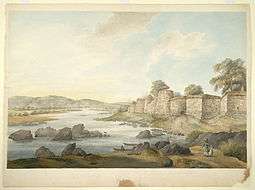Sambalpur State
Sambalpur Raj, also known as Hirakhand samrajya was a sovereign state founded in 16th c AD and ruling over a vast kingdom spread across Western Odisha and Eastern Chhattisgarh districts in Central-Eastern India prior to Maratha occupation in 1800 AD. From 1849 AD it was integrated with British Raj as a British District . Its capital was present Sambalpur city in Wesetrn Odisha.
| Sambalpur State ସମ୍ବଲପୁର | |||||||
|---|---|---|---|---|---|---|---|
| Princely State of British India | |||||||
| 1493–1848 | |||||||
 Former state of Sambalpur as a British district in pink in the Imperial Gazetteer of India | |||||||
| Area | |||||||
• 1901 | 1,399 km2 (540 sq mi) | ||||||
| Population | |||||||
• 1901 | 79,900 | ||||||
| History | |||||||
• Foundation of the state | 1493 | ||||||
• Annexed by the British Raj | 1848 | ||||||
| |||||||

History
Sambalpur State was founded in mid 15th century by Balaram Deo,[1] a Rajput from Chauhan dynasty and younger brother of kingdom of Patna ruler Raja Narsingh Deo . In 1540 A.D., the kingdom of Patna, ruled by the Chauhan dynasty was bifurcated. The southern portion of the Ang River was ruled by Narasingh Deb and his brother Balaram Deb received the northern side of the river, known as Kingdom of Huma. Balaram Deb established his new capital at Sambalpur. Sambalpur was ruled by the Chauhan dynasty till 1800. The kingdom of Sambalpur was also known as Hirakhand and Sambalpur was its capital.[2]
The Garhjat states were eighteen vassal states under Sambalpur State.[3] The Sambalpur kings favoured Sarangarh State owing to the readiness of its rulers to help their kingdom during military campaigns. Sambalpur was ruled by the Chauhan dynasty till 1800 when Sambalpur came under the Bhonsle dynasty of Nagpur State.[4]
Sambalpur was invaded and occupied by the Marathas between 1808 and 1817. After the Third Anglo-Maratha War in 1817 the British Government returned Sambalpur to the Chauhan king, Jayant Singh, but his authority over its eighteen vassal states was withdrawn. The state was placed under British administration from 1818 to 1820, when local rule was restored and the principality became a British protectorate. When the ruler or the state died without a direct male heir in 1849, the British seized the state under the doctrine of lapse.
In 1857 during the Sepoy Mutiny there was a rebellion led by Surendra Sai of the Sambalpur ruling family, later renowned as 'Veer' (hero) Surendra Sai. The mutineers broke open the prison at Hazaribagh, where Surendra Sai was imprisoned and released all the prisoners. Surendra Sai fought against the British after reaching Sambalpur, eventually surrendering when the British suppressed the rebellion. In 1858 when Sambalpur was put under British administration it initially became part of the Cuttack division of the Bengal Presidency, but was transferred to the Central Provinces in 1862.[5]
Rajas
- 1494 - 1534 Raja Balram Dev
- 1534-1578 Madhukar Sai
- 1578-1611 Jai Singh
- 1611-1637 Veerbhadra Sai
- 1637-1648 Narsingh Sai
- 1648-1670 Lal Singh
- 1670-1690 Deo Singh
- 1690 - 1725 Chhatrasal
- 1725 - 1732 Ajit Singh
- 1732 - 1778 Abhai Singh
- 1778 - 1782 Balbhadra Sai
- 1782 - 1797 Jayanta Singh (1st time) (d. 1818)
- 1808 - 1817 Maratha occupation
- 1817 - 1818 Jayanta Singh (2nd time) (s.a.)
- 1818 - 1820 British administration
- 1820 - 1827 Maharaj Sai (d. 1827)
- 1827 - 1833 Mohan Kumari (f) -Rani
- 1833 - 1849 Narayan Singh (d. 1849)
- 1849 Mukhyapan Devi (f) -Rani
- 1857 - 1862 Surendra Sai (in rebellion) (b. 1809 - d. 1884)
- 1862 - 1863 Madho Singh Chauhan (in rebellion) (b. 1840 - d. 1884)
References
- Orissa District Gazetteers, Appendix III, Page 86-87
- Historical Sambalpur. Kosal. Retrieved on 2011-01-20.
- Sarangarh Princely State
- Great Britain India Office. The Imperial Gazetteer of India. Oxford: Clarendon Press, 1908.
- Chisholm, Hugh, ed. (1911). . Encyclopædia Britannica. 24 (11th ed.). Cambridge University Press. p. 113.
- Princely States of India